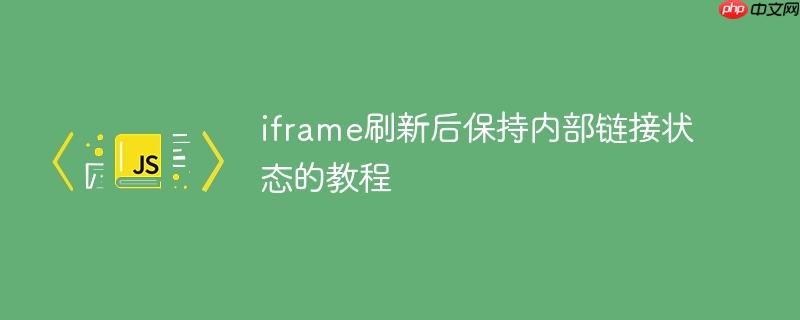
默认情况下,当包含<iframe>元素的父页面刷新时,<iframe>本身并不会记住其内部的导航历史或当前显示的页面。它会简单地重新加载其src属性中指定的初始url。这意味着,如果用户在iframe内部导航了多个页面,刷新父页面后,iframe将回到最初设置的页面,这会极大地影响用户体验,导致信息丢失和操作中断。
例如,以下是一个基本的iframe结构:
<iframe src="https://my-domain.com/pagelink" name="iframe_a" style="width:100%; height:200px;" title="Iframe" id="frame"></iframe>
如果用户在iframe_a中从/pagelink导航到/another-page,刷新父页面后,iframe_a会再次显示/pagelink。为了解决这个问题,我们需要在父页面中介入,主动管理和恢复iframe的状态。
第一种方法是手动跟踪iframe的导航,并将其当前URL存储在浏览器的本地存储(sessionStorage或localStorage)中。当父页面重新加载时,我们可以从存储中读取这个URL,并将其应用到iframe的src属性上,从而恢复iframe到之前的状态。
监听iframe内部导航变化:由于安全限制(同源策略),父页面通常无法直接访问iframe内部的window.location.href,除非iframe与父页面同源。如果同源,可以通过监听iframe的load事件来获取其当前的location.href。如果不同源,情况会复杂很多,可能需要iframe内部主动通过window.parent.postMessage()向父页面发送消息来报告其URL变化。
const iframe = document.getElementById('frame');
iframe.onload = function() {
try {
// 尝试获取iframe的当前URL
const currentIframeUrl = iframe.contentWindow.location.href;
console.log('Iframe navigated to:', currentIframeUrl);
// 将URL保存到sessionStorage
sessionStorage.setItem('iframeUrl', currentIframeUrl);
} catch (e) {
console.warn('无法访问iframe内容,可能存在跨域问题:', e);
// 跨域处理,或者假设iframe内容会自行通知
}
};// 在iframe内部的页面中
window.onload = function() {
if (window.parent) {
// 假设父页面与iframe的根URL相同,或者知道具体的父页面源
window.parent.postMessage({ type: 'iframeUrlChange', url: window.location.href }, '*');
}
};父页面监听:
window.addEventListener('message', function(event) {
// 建议检查 event.origin 以提高安全性
if (event.data && event.data.type === 'iframeUrlChange' && event.data.url) {
sessionStorage.setItem('iframeUrl', event.data.url);
}
});选择存储方式:
页面加载时恢复iframe状态: 在父页面加载完成后,检查存储中是否有之前保存的iframe URL。如果有,则将iframe的src属性设置为该URL。
document.addEventListener('DOMContentLoaded', function() {
const iframe = document.getElementById('frame');
const savedIframeUrl = sessionStorage.getItem('iframeUrl');
if (savedIframeUrl) {
iframe.src = savedIframeUrl;
console.log('Restored iframe to:', savedIframeUrl);
} else {
// 如果没有保存的URL,则加载初始URL
iframe.src = "https://my-domain.com/pagelink";
}
});更推荐且更强大的方法是利用HTML5的history.pushState() API,将iframe的当前URL信息编码到父页面的URL中。这样,父页面的URL就成为了整个应用状态的“序列化”表示,包括了iframe的当前页面。
当iframe内部发生导航时,父页面会捕获这一变化(无论是通过同源访问还是postMessage),然后使用history.pushState()修改父页面的URL,将iframe的路径作为查询参数或哈希片段添加到父页面的URL中。例如,如果iframe显示/another-page,父页面URL可能变为https://my-domain.com/parent-page?iframePath=/another-page或https://my-domain.com/parent-page#/iframe/another-page。
当父页面刷新或通过URL直接访问时,父页面会解析URL中的iframe路径信息,并据此设置iframe的src。
定义URL结构:决定如何将iframe路径编码到父页面URL中。查询参数 (?iframePath=...) 或哈希片段 (#/iframe/...) 都是常见的选择。哈希片段的好处是修改它不会导致页面刷新。
例如,使用哈希片段: https://my-domain.com/parent-page#/iframe/another-page
监听iframe导航并更新父页面URL:
同源场景:在iframe的onload事件中,获取其location.pathname或location.href,并使用history.pushState()更新父页面URL。
const iframe = document.getElementById('frame');
iframe.onload = function() {
try {
const iframePath = iframe.contentWindow.location.pathname; // 或更完整的href
// 构建新的URL,例如使用哈希路由
const newUrl = window.location.pathname + window.location.search + '#/iframe' + iframePath;
history.pushState({ iframePath: iframePath }, '', newUrl);
console.log('Parent URL updated:', newUrl);
} catch (e) {
console.warn('无法访问iframe内容,可能存在跨域问题:', e);
}
};跨域场景:iframe内部页面通过postMessage发送其路径,父页面接收后更新URL。
// 在iframe内部的页面中
window.onload = function() {
if (window.parent) {
window.parent.postMessage({ type: 'iframeUrlChange', path: window.location.pathname }, '*');
}
};
// 在父页面中
window.addEventListener('message', function(event) {
// 建议检查 event.origin 以提高安全性
if (event.data && event.data.type === 'iframeUrlChange' && event.data.path) {
const iframePath = event.data.path;
const newUrl = window.location.pathname + window.location.search + '#/iframe' + iframePath;
history.pushState({ iframePath: iframePath }, '', newUrl);
}
});父页面加载时解析URL并恢复iframe状态: 在父页面加载时,解析当前URL的哈希片段或查询参数,提取出iframe的路径,然后设置iframe的src。
document.addEventListener('DOMContentLoaded', function() {
const iframe = document.getElementById('frame');
const hash = window.location.hash; // 获取哈希片段,例如 "#/iframe/another-page"
const iframeBaseUrl = "https://my-domain.com"; // iframe的根URL
if (hash.startsWith('#/iframe/')) {
const iframe以上就是iframe刷新后保持内部链接状态的教程的详细内容,更多请关注php中文网其它相关文章!

每个人都需要一台速度更快、更稳定的 PC。随着时间的推移,垃圾文件、旧注册表数据和不必要的后台进程会占用资源并降低性能。幸运的是,许多工具可以让 Windows 保持平稳运行。

Copyright 2014-2025 //m.sbmmt.com/ All Rights Reserved | php.cn | 湘ICP备2023035733号